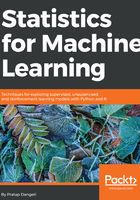
Example of lasso regression machine learning model
Lasso regression is a close cousin of ridge regression, in which absolute values of coefficients are minimized rather than the square of values. By doing so, we eliminate some insignificant variables, which are a very much compacted representation similar to OLS methods.
The following implementation is similar to ridge regression apart from penalty application on mod/absolute value of coefficients:
>>> from sklearn.linear_model import Lasso
>>> alphas = [1e-4,1e-3,1e-2,0.1,0.5,1.0,5.0,10.0]
>>> initrsq = 0
>>> print ("\nLasso Regression: Best Parameters\n")
>>> for alph in alphas:
... lasso_reg = Lasso(alpha=alph)
... lasso_reg.fit(x_train,y_train)
... tr_rsqrd = lasso_reg.score(x_train,y_train)
... ts_rsqrd = lasso_reg.score(x_test,y_test)
... if ts_rsqrd > initrsq:
... print ("Lambda: ",alph,"Train R-Squared value:",round(tr_rsqrd,5),"Test R-squared value:",round(ts_rsqrd,5))
... initrsq = ts_rsqrd
This is shown in the following screenshot:

>>> ridge_reg = Ridge(alpha=0.001)
>>> ridge_reg.fit(x_train,y_train)
>>> print ("\nRidge Regression coefficient values of Alpha = 0.001\n")
>>> for i in range(11):
... print (all_colnms[i],": ",ridge_reg.coef_[i])
>>> lasso_reg = Lasso(alpha=0.001)
>>> lasso_reg.fit(x_train,y_train)
>>> print ("\nLasso Regression coefficient values of Alpha = 0.001\n")
>>> for i in range(11):
... print (all_colnms[i],": ",lasso_reg.coef_[i])
The following results show the coefficient values of both methods; the coefficient of density has been set to 0 in lasso regression, whereas the density value is -5.5672 in ridge regression; also, none of the coefficients in ridge regression are zero values:

The R code for lasso regression on the wine quality data is as follows:
# Above Data processing steps are same as Ridge Regression, only below section of the code do change
# Lasso Regression
print(paste("Lasso Regression"))
lambdas = c(1e-4,1e-3,1e-2,0.1,0.5,1.0,5.0,10.0)
initrsq = 0
for (lmbd in lambdas){
lasso_fit = glmnet(x_train,y_train,alpha = 1,lambda = lmbd)
pred_y = predict(lasso_fit,x_test)
R2 <- 1 - (sum((test_data[,yvar]-pred_y )^2)/sum((test_data[,yvar]-mean(test_data[,yvar]))^2))
if (R2 > initrsq){
print(paste("Lambda:",lmbd,"Test Adjusted R-squared :",round(R2,4)))
initrsq = R2
}
}